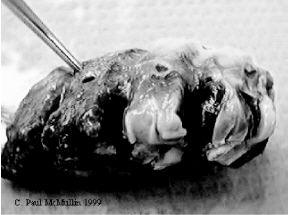



Ornithobacterium Infection, ORT
Introduction
Ornithobacterium Infection is an infection of chickens and turkeys with the bacterium Ornithobacterium rhinotracheale (ORT). This was first identified as a new disease syndrome of turkeys in Germany in the early 1990s. The slow-growing bacterium was named in 1994. It had been previously isolated in a number of other countries. The infection is common in chickens and turkeys.
The severity of its effects depends on the pathogenicity of the particular strain and other risk factors such as viral infections, ventilation problems, age at infection etc.
Inoculation of fresh material from a case can reproduce lung lesions similar to those caused by Pasteurella multocida infection in previously uninfected turkeys over 10 weeks of age. It commonly exacerbates respiratory disease caused by pneumovirus infections in turkeys. In broiler chickens its main importance seems to be as a cause of airsacculitis in apparently healthy flocks that is only identified at slaughter. This can cause significant losses through condemnations.
Important cofactors may include respiratory viral vaccines (Newcastle disease, Infectious Bronchitis), field challenge with respiratory viruses, Bordetella avium infection, and E. coli infections.
Some uncertainty exists about mechanisms of transmission. Within the poultry house it is likely to be by aerosols, direct contact and drinkers. There is some evidence that hatcheries may play a role in the epidemiology, perhaps through survival of the organism on shell surfaces or shell membranes. A range of sero-types have been identified. The range occurring in turkeys is wider than that seen in chickens.
Signs
- Coughing, sneezing.
- Reduced weight gain.
- Reduced egg production.
Post-mortem lesions
- Airsacculitis, tracheitis, severe bronchopneumonia.
Diagnosis
Clinical signs and lesions. Confirmation is by isolation of the organism. Cultures from the trachea of birds showing typical signs are preferred. The organism grows slowly producing tiny colonies on blood agar. Growth is more rapid and consistent in an anaerobic jar. E. coli overgrowth may occur. It is a Gram-negative pleomorphic organism. Most isolates are oxidase positive and galactosidase positive Serology using Elisa tests has been used, preferably as a flock test comparing results before and after the challenge.
Treatment
The sensitivity of ORT to antibiotic is highly variable. Initially in Germany most strains were sensitive to amoxycillin, chlortetracycline but not to enrofloxacin. Amoxycillin sensitivity remains good, also most are sensitive to tiamulin. In France and Belgium most strains were sensitive to enrofloxacin. In the USA in 1998 all strains were sensitive to penicillins and many other microbials, though 54% were sensitive to tetracycline, neomycin and enrofloxacin.
Routine treatment - amoxycillin at 250 ppm in water for 3-7 days or chlortetracycline at 500 ppm for 4-5 days. Tilmicosin is also effective at 10-20mg/kg and should be used in the early stages of the disease.
Prevention
This is based on good hygiene, therapy and vaccination. Hygiene - it is very sensitive in vitro to a range of chemicals. ORT is a major problem on multi-age sites. Preventative medication with the products listed in the previous section may be beneficial in some circumstances.
Vaccination - there are issues relating to availability, regulation, cost etc. Some work has been done on live vaccine in the USA. An inactivated vaccine is licensed for broiler parents in Europe; it requires two doses. Some vaccines seem to have difficulty in producing a long-lasting serological response to ORT.
Vaccination of breeder flocks to protect progeny has shown benefits in chickens but, because of the age of slaughter, this is unlikely to work in turkeys. Satisfactory disease control depends on good management and biosecurity.
 |
| Figure 27. Severely consolidated lung from an acute ORT infection in 14-week-old turkey growers. The lung is solid and covered by pus/ purulent exudate. Similar lesions may be found in Pasteurellosis. |







